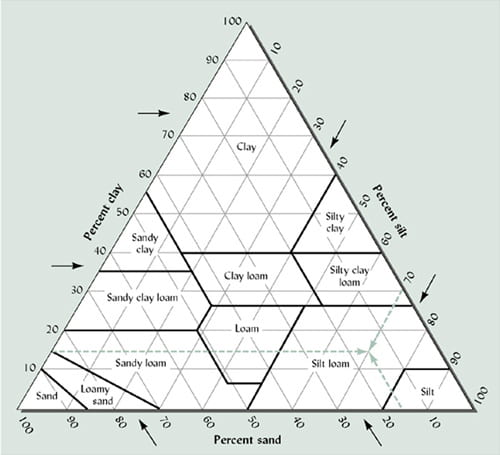The amount of water, air and nutrients available for plant growth is affected by the soil physical properties and turf management practices that include watering, mowing, and aerifying and how much the fields are used. Determining the physical properties of your soils will ultimately help you determine how to manage them effectively.
Soil Texture
Soil texture is based on the relative proportion of sand, silt and clay the soil contains and is used to name the soil, for example a sandy loam soil.
Coarse-textured soils (sands, loamy sands, sandy loams) have a large particle size and do not have great water and nutrient holding capacity. They tend to be well drained, dry out faster, and are less likely to compact. Fine-textured soils (clays, sandy clays, silty clays) have a small particle size. They can hold water and nutrients, take time to dry out, can be easily compacted when wet and often are associated with poor drainage that limits the use of the fields during wet weather.
Soil texture will influence watering and fertilizing management practices on sports fields.
General soil physical and chemical properties of different soil textures
| Soil texture | Drainage | Susceptibility to compaction | Water & nutrient-holding capacity |
|---|---|---|---|
| sand | excellent | little to none | limited |
| loamy sand | excellent | limited | limited |
| sandy loam | good | limited to moderate | moderate |
| loam | good to fair | moderate | moderated – substantial |
| silt loam | fair to poor | substantial | substantial |
| clay loam | fair to poor | substantial | substantial |
| clay | poor | substantial | substantial |
Soil Type
Knowing the soil type is important and can differ from area to area and from field to field. The name of the soil is also necessary when submitting a soil sample for nutrient analysis.
If you are not familiar with the soils you have, you can have a customized Soil Resource Report generated for a particular parcel of land by going to the NRCS (Natural Resources Conservation Service) Web Soil Survey website.
Or you can use the SoilWeb for the iPhone app from the California Soil Resource Lab. (Also available for Android.) This application retrieves graphical summaries of soil types associated with the phone’s current geographic location. Sketches of soil profiles are linked to their official soil series description.
If soils were brought onto the site, the above methods for determining soil type may not be very useful. Some soil testing laboratories (including the Cornell Soil Health Testing Lab) can determine soil texture. Also, you can get a good idea of the soil texture by following the texture by feel method.
Soil structure
Soil structure refers to the arrangement or grouping of soil particles into granules or blocks of soils in various sizes and shapes. A well aggregated soil is good for plant growth because the wider range of pores provides better drainage, aeration and water storage and places for roots to grow. Soil aggregates (crumbs, or clumps) are formed when soil minerals and organic matter are bound together with the help of organic molecules, plant roots, fungi and clays.
Both air and water occupy the pores spaces created within and between soil aggregates. Air can be found in the larger pores (macropores) and water is held in the smaller pores (micropores).
Soil structure can be destroyed by over use and traffic and can be improved over time by incorporating amendments through topdressing.



